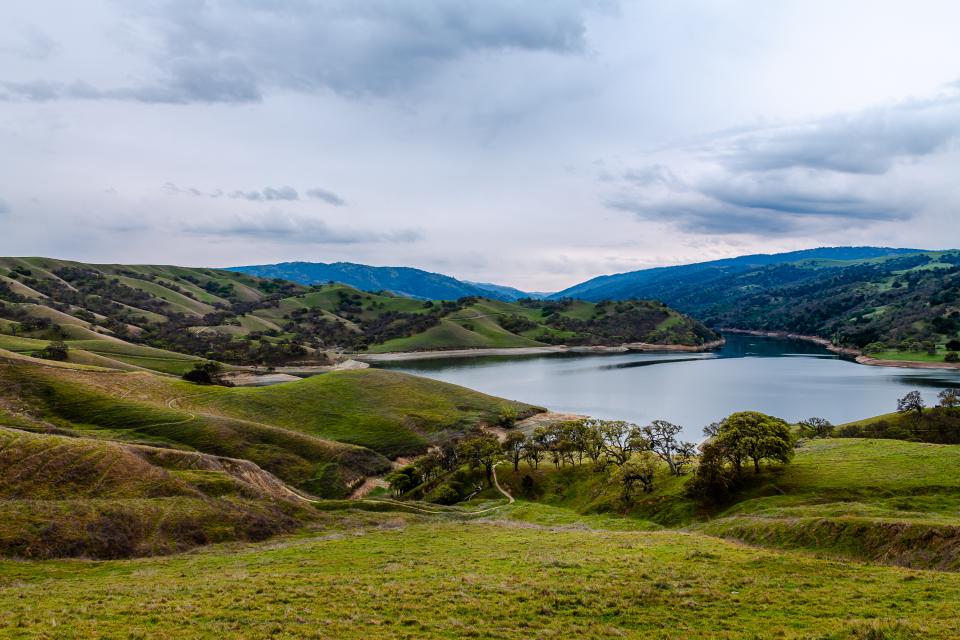Banking for Non-Rainy Days
Our Groundwater Basin “Bank Account”
Unlike most other Bay Area communities, the Tri-Valley benefits from local water-storage capacity in an underground basin that provides us with increased water-supply reliability.
Operating the basin as a bank account, Zone 7 during wet years uses a portion of its State Water Project water coming through the Bay-Delta, along with local surface runoff water stored in Del Valle Reservoir, to recharge the groundwater basin. This is done via release of water into local streams that then percolates into the underground aquifer. We draw stored water to augment imported water supplies, especially during the summer when seasonal water demands are the highest, and in times of drought. Recharge also helps dilute the natural hardness of groundwater.
Zone 7 had been in its infancy when the first State Water Project deliveries were made in 1962, and it marked the beginning of sustainable groundwater management locally. Zone 7 initially used all of its early State Water Project deliveries to replenish the groundwater basin that had been over-pumped over the previous decades. Groundwater recharge using imported surface water supplies continued even after Zone 7’s treatment plants opened, and has been a critical component of Zone 7’s water resources management ever since.
Protecting the Groundwater Basin’s levels
The Tri-Valley’s main groundwater basin is the Livermore Valley Groundwater Basin. It has an estimated storage capacity of 250,000 acre-feet (an acre-foot is about 326,000 gallons, which is enough to supply water to two average households per year). To prevent overpumping, the basin is cooperatively managed by Zone 7 and its retailers so that even during multi-year droughts, groundwater levels do not drop below historic low levels of 130,000 acre-feet. This helps us ensure this important “savings account” is there when we need it and prevents subsidence.
A Long-Term Asset
Zone 7 is working to boost its surface-water treatment capacity so it can rely less on groundwater to meet demand in normal rainfall years. Nevertheless, the basin remains a critical component of reliability planning:
-
Through our future Chain of Lakes project, created from a series of abandoned gravel quarries between Livermore and Pleasanton, Zone 7 plans to increase groundwater recharge during wet years with imported water supplies.
-
As part of its Well Master Plan, the agency is planning new wells — two that came online in the Chain of Lakes area in 2010 — to ensure sufficient production during surface-water shortages.
How Water Banking Works
Think of water banking the same way you would think of your bank account. We put water into different accounts, but can transfer between them when necessary. The South Bay Aqueduct and State Water Project make this possible, essentially operating as an ATM. When we put a dollar into our savings account at the bank, then make a withdrawal from an ATM, we don’t get the exact same dollar out. Water banking works the same way. We can take water from the South Bay Aqueduct, but we can only take as much as have stored in our offsite water banks.
Our Offsite Banking Programs
Offsite Reservoir Banking
Our most readily available stored water resource outside Zone 7’s service area is San Luis Reservoir in Merced County. We have up to 40,000 acre-feet of storage capacity in this reservoir (depending on hydrology) and keep on average of 10,000 acre-feet annually to supplement our State Water Project allocation.
Offsite Groundwater Banking
Zone 7 also has groundwater-banking rights in Kern County, allowing us to store surplus state water supplies during wet years, and to draw upon when needed during a drought. We have 65,000 acre-feet of groundwater storage capacity in the Semitropic Water Storage District and another 120,000 acre-feet of capacity in the Cawelo Water District.

